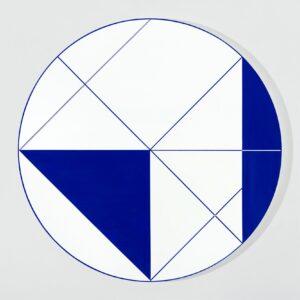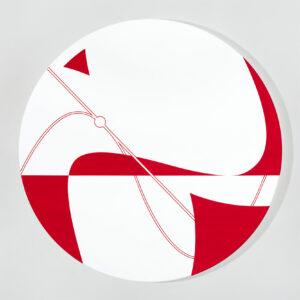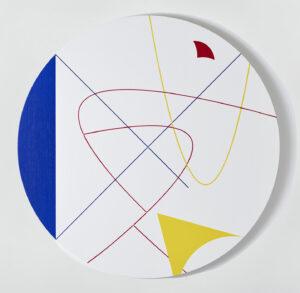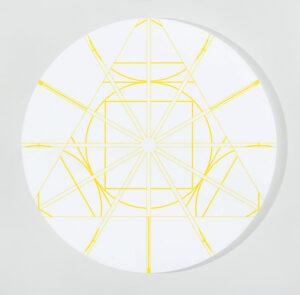





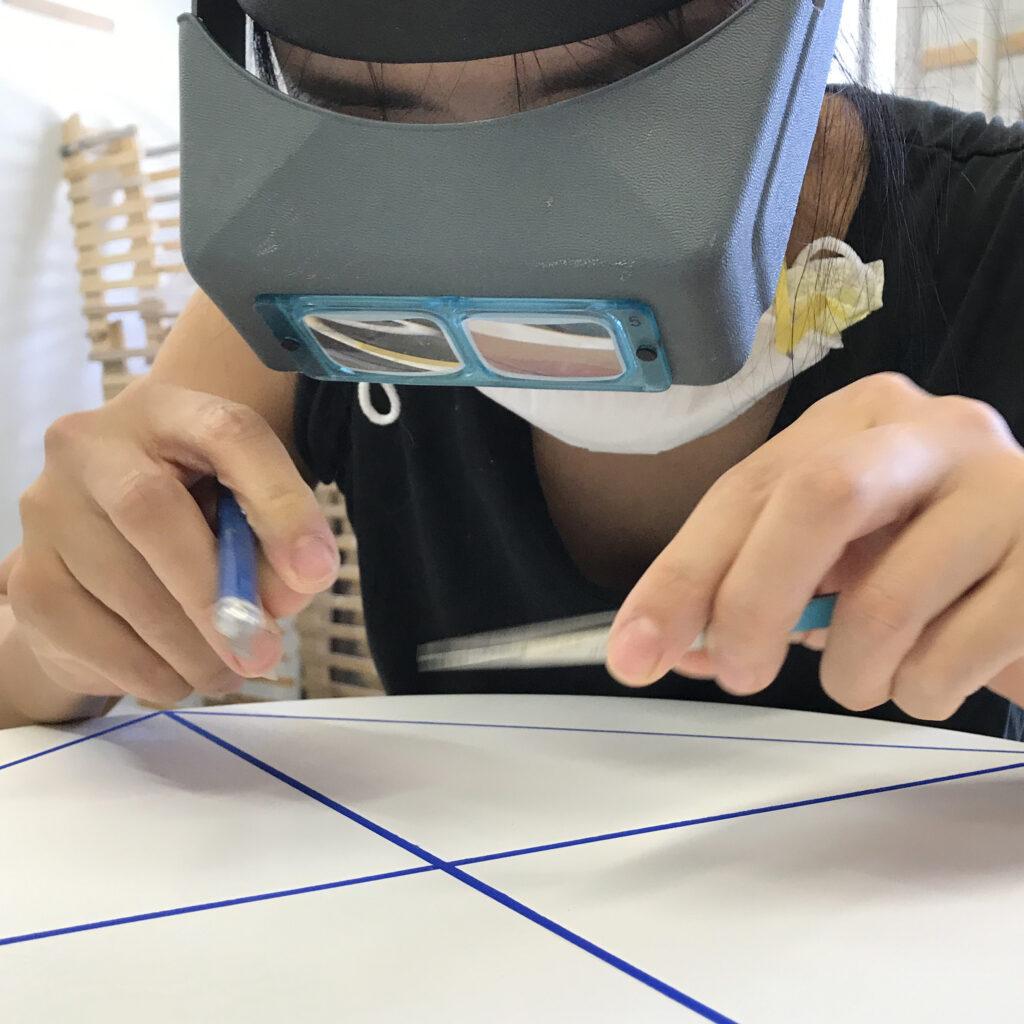
Kim Heejo earned a bachelor’s (2006) in fine arts at the School of Visual Arts and a master’s degree (2018) in painting and sculpture at New York Studio School. Since 2009, she has held solo and group exhibitions in New York and Milan, and currently lives and works in Seoul since 2019.
In her first solo exhibition《BYR: Prime Elements》held in Seoul in 2019, Kim Heejo presented works with completely different content and format. She devised the schemata system after creating 99 BYR: Prime Elements, a combination of 33 blues and squares, yellows and triangles, and reds and circles.
Through this system, the artist integrated paintings, sculptures, and objects into linear and non-linear forms, and presented the concept of a new medium in contemporary art.
- Works for Sale
- Artistic Career
- World of Work
- Activity
Schematic Medium & BYR 99
Schematic Medium & BYR 99
Solo Exhibitions (Brief)
Kim Heejo held her first solo exhibition 《Hello, Dolly!》 (2009, Galleria gli Eroici Furori) in Milan, Italy, and has been mainly active in the United States.
After holding solo exhibitions 《The Series》(2010, Blank Space Gallery, New York, USA) and 《New Works, ‘Double Toil and Trouble’》 (New York Studio School of Drawing, Painting and Sculpture, New York, USA), her first in Korea she had a solo exhibition 《BYR: Prime Elements》 (2020, UARTSPACE, Seoul, Korea).
Group Exhibitions (Brief)
Participated in group exhibitions held at Centotto Gallery (New York, USA), Bowery Gallery (New York, USA), Main Gallery (New York, USA), Interalia Gallery (Seoul, Korea), Insa Art Center (Seoul, Korea), Blank Space New York Gallery (Seoul, Korea), Gana Art Center (Seoul, Korea).
Awards (Selected)
She was the recipient of the Herzog-Meier Award in Art (Oregon, USA) in 1999 and the Pamela Brown Roberts Award (New York, USA) in 2004.
Schematic Medium & BYR 99
Schematic Medium & BYR 99
Originality & Identity
Kim Heejo showed her first solo exhibition in 《Hello, Dolly!》. The exhibited works were painting types drawn in different painting techniques illustrating a repeated character, the cloned sheep ‘Dolly’.
The artist moved to New York in 2003, and she got the feeling that there is a strong lack of new ideas among artists and too many copies in the contemporary visual art world. Moreover, she felt marginalized in the visual art scene, so-called ‘colonized art’.
Her awareness led to questions about artistic identity and was expressed in a series of paintings of “Dolly; the sheep”, the first usage of “Dolly” as an object of art. It has a special meaning that the world’s first genetically cloned animal is duplicated in her art painting.
Kim Heejo insists that 90% of the possibilities of visual art had already been explored, so she focused on work beyond reality. This study focused on the limitations and finiteness caused by the discrepancy between the ideological world and the phenomenological world based on the question of after existence.
Hence, the topic deals with ontological imperfection. She visually expresses her own ontological responses arising in the course of her research. Specifically, she devised a special conceptual framework and integrated mechanism, called ‘Schemata,’ in order to express complex and multifaceted views.
‘Schemata’ originally refers to a knowledge structure that consists of the information we have about certain objects. Here, the artist deals with encompassing schemata as a way of seeing and perceiving the world as well as a methodology of her artistic expression.
“My visual language does not address a single or independent subject.”
In Kim Heejo’s artworks, dozens and hundreds of interconnected pieces compose highly related series. Individual works are produced using line, form, style, and colour as basic formulas. However, the artist’s schemata are conveyed through analysis and separation, independence and combination, and sequencing and re-contextualization derived from the artist’s point of view and concept.
Likewise, Kim Heejo perfectly shows her insight and artistic synthesis by organically connecting the world with her own worldview in her works, not just only with her visual expression.
Style & Contents
In Kim Heejo’s method to show her art and worldview through the ‘Schemata Chart,’ a schematic system, there exists a basis called ‘BYR Prime Elements,’ an organic cluster that unlocks the origins of thinking.
The artist adopts the BYR frame as a circle that symbolizes the beginning to the end. BYR represents images such as the space occupied by humans, and the earth’s circular motion as its basic structure, and transforms it into three units: blue B, yellow Y, and red R.
Here, ‘B’ is based on a ‘square,’ starting from the four points of its form. Then, it is omitted, expanded, and combined with the shape of a circle. This represents not only the psychological inherent interest in a specific culture and self-reflection, but it also means the state of mind and matters encountered in life.
With the motif of ‘equilateral triangle,’ ‘Y’ represents the harmonious structure, repetition, rhythm, and gravity of the universe through the artist’s unique pattern and analytic methodology. It is an interpretation of cosmological events such as birth, growth, and death.
The last one, ‘R’ starts from the ‘point’ representing the particles. The unit ‘R’ is composed of streamlined and non-linear curves in harmony with several points, tracking the interaction between particles and environments nearby. It illustrates the physical laws of nature, like gravity, energy transfer, orbit, and light.
Kim Heejo’s BYR refers to the artist’s learning, growth, reflection, and actions out of the meta-awareness of the events and flows of the universe, and its properties and natural law. BYR units, changing and expanding the crucial basic formulas and forming the artist’s typology, create an artistic formative middle ground via physical bonding and chemical fusion in the art world.
Constancy & Continuity
Kim Heejo’s recent solo exhibition 《BYR: Prime Elements》 shows her featured 99 works of her own Prime Elements, synthesized with her art view, schemata cart, and well organized artistic identity. In this exhibition, the artist presented ‘BYR_OS’, showing the initial stage of Schematic Medium as the final art form integrating all art contents like paintings, sculptures, drawings, and objects into one system and concept.
It is Kim Heejo’s unique artistic achievement to establish a conceptual system by combining the artist’s own methods with the traditional painting. Furthermore, the future of her artworks is expected more in her artistic character enlarging in multifaceted connection and interaction with the actual works in the world.
Schematic Medium & BYR 99
Schematic Medium & BYR 99
Schematic Medium & BYR 99
Schematic Medium & BYR 99
- Works for Sale
- Artistic Career
- World of Work
- Activity
Schematic Medium & BYR 99
Schematic Medium & BYR 99
Solo Exhibitions (Brief)
Kim Heejo held her first solo exhibition 《Hello, Dolly!》 (2009, Galleria gli Eroici Furori) in Milan, Italy, and has been mainly active in the United States.
After holding solo exhibitions 《The Series》(2010, Blank Space Gallery, New York, USA) and 《New Works, ‘Double Toil and Trouble’》 (New York Studio School of Drawing, Painting and Sculpture, New York, USA), her first in Korea she had a solo exhibition 《BYR: Prime Elements》 (2020, UARTSPACE, Seoul, Korea).
Group Exhibitions (Brief)
Participated in group exhibitions held at Centotto Gallery (New York, USA), Bowery Gallery (New York, USA), Main Gallery (New York, USA), Interalia Gallery (Seoul, Korea), Insa Art Center (Seoul, Korea), Blank Space New York Gallery (Seoul, Korea), Gana Art Center (Seoul, Korea).
Awards (Selected)
She was the recipient of the Herzog-Meier Award in Art (Oregon, USA) in 1999 and the Pamela Brown Roberts Award (New York, USA) in 2004.
Schematic Medium & BYR 99
Schematic Medium & BYR 99
Originality & Identity
Kim Heejo showed her first solo exhibition in 《Hello, Dolly!》. The exhibited works were painting types drawn in different painting techniques illustrating a repeated character, the cloned sheep ‘Dolly’.
The artist moved to New York in 2003, and she got the feeling that there is a strong lack of new ideas among artists and too many copies in the contemporary visual art world. Moreover, she felt marginalized in the visual art scene, so-called ‘colonized art’.
Her awareness led to questions about artistic identity and was expressed in a series of paintings of “Dolly; the sheep”, the first usage of “Dolly” as an object of art. It has a special meaning that the world’s first genetically cloned animal is duplicated in her art painting.
Kim Heejo insists that 90% of the possibilities of visual art had already been explored, so she focused on work beyond reality. This study focused on the limitations and finiteness caused by the discrepancy between the ideological world and the phenomenological world based on the question of after existence.
Hence, the topic deals with ontological imperfection. She visually expresses her own ontological responses arising in the course of her research. Specifically, she devised a special conceptual framework and integrated mechanism, called ‘Schemata,’ in order to express complex and multifaceted views.
‘Schemata’ originally refers to a knowledge structure that consists of the information we have about certain objects. Here, the artist deals with encompassing schemata as a way of seeing and perceiving the world as well as a methodology of her artistic expression.
“My visual language does not address a single or independent subject.”
In Kim Heejo’s artworks, dozens and hundreds of interconnected pieces compose highly related series. Individual works are produced using line, form, style, and colour as basic formulas. However, the artist’s schemata are conveyed through analysis and separation, independence and combination, and sequencing and re-contextualization derived from the artist’s point of view and concept.
Likewise, Kim Heejo perfectly shows her insight and artistic synthesis by organically connecting the world with her own worldview in her works, not just only with her visual expression.
Style & Contents
In Kim Heejo’s method to show her art and worldview through the ‘Schemata Chart,’ a schematic system, there exists a basis called ‘BYR Prime Elements,’ an organic cluster that unlocks the origins of thinking.
The artist adopts the BYR frame as a circle that symbolizes the beginning to the end. BYR represents images such as the space occupied by humans, and the earth’s circular motion as its basic structure, and transforms it into three units: blue B, yellow Y, and red R.
Here, ‘B’ is based on a ‘square,’ starting from the four points of its form. Then, it is omitted, expanded, and combined with the shape of a circle. This represents not only the psychological inherent interest in a specific culture and self-reflection, but it also means the state of mind and matters encountered in life.
With the motif of ‘equilateral triangle,’ ‘Y’ represents the harmonious structure, repetition, rhythm, and gravity of the universe through the artist’s unique pattern and analytic methodology. It is an interpretation of cosmological events such as birth, growth, and death.
The last one, ‘R’ starts from the ‘point’ representing the particles. The unit ‘R’ is composed of streamlined and non-linear curves in harmony with several points, tracking the interaction between particles and environments nearby. It illustrates the physical laws of nature, like gravity, energy transfer, orbit, and light.
Kim Heejo’s BYR refers to the artist’s learning, growth, reflection, and actions out of the meta-awareness of the events and flows of the universe, and its properties and natural law. BYR units, changing and expanding the crucial basic formulas and forming the artist’s typology, create an artistic formative middle ground via physical bonding and chemical fusion in the art world.
Constancy & Continuity
Kim Heejo’s recent solo exhibition 《BYR: Prime Elements》 shows her featured 99 works of her own Prime Elements, synthesized with her art view, schemata cart, and well organized artistic identity. In this exhibition, the artist presented ‘BYR_OS’, showing the initial stage of Schematic Medium as the final art form integrating all art contents like paintings, sculptures, drawings, and objects into one system and concept.
It is Kim Heejo’s unique artistic achievement to establish a conceptual system by combining the artist’s own methods with the traditional painting. Furthermore, the future of her artworks is expected more in her artistic character enlarging in multifaceted connection and interaction with the actual works in the world.

